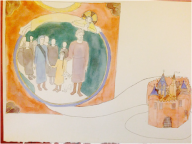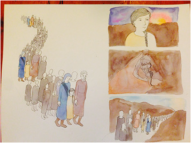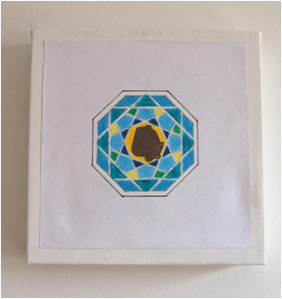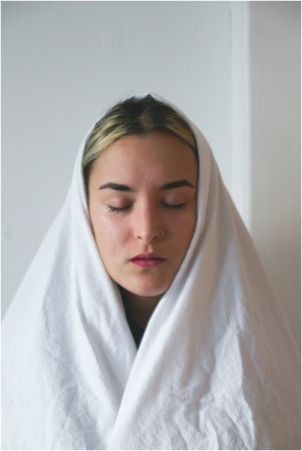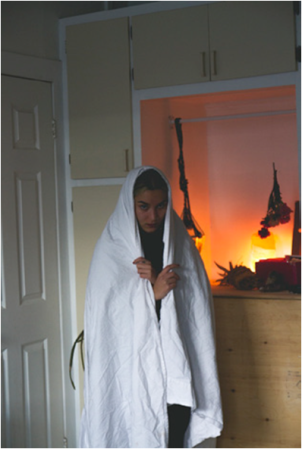
Dr Loren Lerner, beside a work created for the course by student Anna Campbell, titled ‘Design for an Ideal Starlight’.
Imagining Jerusalem network member Dr Loren Lerner is professor of Art History at Concordia University, Montreal, where she teaches a course called ‘The City of Jerusalem: Ideas and Images’. Loren kindly agreed to be interviewed about the course for this blog, and our conversation is below.
Hannah: What are your aims for the course? Can you give us an idea of its scope, structure, and the primary materials that you use?
Loren: The syllabus outlines the topics covered, learning activities, expected outcomes and the bibliography of readings. I have culled the readings from many disciplines. This is because I found few books and journal articles devoted to the art history of Jerusalem. As well, I want the students to be acquainted with writings on the art and architecture of Jerusalem from the fields of archaeology, history, religion, anthropology and sociology and by scholars from different backgrounds and environments. Below, is the course description.
ARTH 369/2A The City of Jerusalem: Ideas and Images
Over the centuries, Jerusalem has been called Shalem, Yerushalayim, City of Melchizedek, City of the Great King or City of David, Aelia Capitolina, Prototype of the Heavenly Jerusalem, Bayt al-Maqdis or al-Quds, and City of Peace. This course considers these different attachments to Jerusalem through visual perceptions and artistic representations at the religious, social and political levels. With a focus on the art and architecture of ancient times, we will examine Jerusalem’s multifaceted religious narratives, allegiances, and ideas, including the “heavenly” Jerusalem that has existed in the minds of believers and artists since the Hebrew Bible. Beginning with the Bronze Age and the First Temple and Second Temple periods, this attention to Jerusalem’s ancient era will be a persistent theme in an extensive study of the city’s history that covers the Roman period, Byzantine Jerusalem, the Arab, Crusader and Mamluk periods, the years under Ottoman rule (1517-1917), the British Mandate (1917-1948), Jerusalem’s division and reunification (1948-1967), and Israel today.
Hannah: Were there preconceptions about Jerusalem that you were trying to tackle when devising the course?
Loren: I have not had a problem in this regard because the students, so far, have few preconceived notions about Jerusalem or opinions based on biases or prejudices. The multicultural character of the city of Montreal and Concordia University’s diverse student population are factors that have contributed to the open-minded reception of this course.
These are some of reasons why I developed this course on Jerusalem:
- to examine forms of artistic expression including architecture, sculpture, painting and other media from across a variety of cultural identities so as to encourage respect for the art of these different communities
- to demonstrate how an expanse of history depends mainly on how one reads the evidence
- to encourage an understanding of human experiences from the viewpoint of others who interpret the world in significantly dissimilar ways
- to integrate a large historical perspective that reveals the changes in the art of particular eras, as well as the continuities of religious, ethical and social values
- to explore artistic productions and cultural practices that construct identity, influence public discourse and act as catalysts for social and political changes
Hannah: Has there been anything in student responses that you didn’t expect, or anything that they found particularly surprising when learning about Jerusalem?
Loren: I was pleasantly surprised by the students’ enthusiasm for Jerusalem. Since a good many of the students in this class are artists in Concordia’s studio arts programs, they could, for their major assignment, create a work of art, reflecting a visual response to this ancient city as a site of major world religions. The work of art had to be accompanied by an exploratory text. Below are six works and short descriptions excerpted from the student essays. (For the complete texts see the first issue of the Jerusalem Art History Journal: An Undergraduate eJournal/Histoire de l’art à Jérusalem : cyberrevue étudiante de premier cycle).
(Click the images to enlarge)
Three Religions, Three Sacred Sights
Eduardo Mazzonna
In this print, Three Religions, Three Sacred Sights, Eduardo decided to include the Church of the Holy Sepulchre, the Dome of the Rock and the Western Wall. He reveals how light, in association with colour, shape, and decorative elements plays a significant symbolic role in these structures.
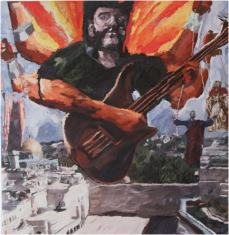 Jerusalem Belongs to No One and Everyone
Jerusalem Belongs to No One and Everyone
Patrick Martel
Patrick’s painting, Who’d win in a wrestling match…. (Lemmy or God), is titled after an iconic scene from the cult movie Airheads in which Lemmy Killmeister of heavy metaldom is often referred to by his nickname “God.” Patrick asks if all three religions worship the same god, and all three have their own version of the end of days, and all three believe this event will lead to the annihilation of the non-believers, would this event not ultimately result in the annihilation of everyone? How, Patrick asks, can Judaism, Christianity, and Islam pretend to have primacy over each other?
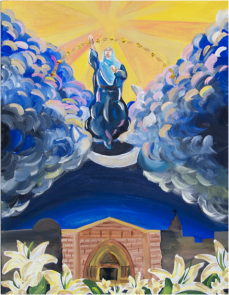 Immaculate Mary: A Reflection on the Assumption of the Blessed Virgin Mary and the Tomb of the Virgin in the Kidron Valley, Jerusalem
Immaculate Mary: A Reflection on the Assumption of the Blessed Virgin Mary and the Tomb of the Virgin in the Kidron Valley, Jerusalem
Elsbeth Cossar
Elsbeth’s artwork titled Immaculate Mary is based on an in-depth exploration of the theological debates concerning the Virgin Mary’s Assumption. With symbols taken from the Book of Revelation she presents the moment of the Assumption of Mary who is brought into a golden, heavenly realm through the parting clouds surrounded by a crown of twelve stars with the crescent moon at her feet. In this work the door of the tomb is wide-open, leading down into a dark area and there are two iconic rooftops (the Dome of the Rock and the Church of the Holy Sepulchre). This is to emphasize that the tomb depicted is the one in Jerusalem, as there is controversy over the true location of the tomb, either Jerusalem or Ephesus.
Histoire d’Esme: An Imagined Story of a Ten-year Old Pilgrim to Jerusalem in the Twelfth Century
Faith Wiley
When Faith first saw the manuscript illuminations of the Crusades the images reminded her of contemporary graphic novels and children’s books. Her awareness that the depictions commonly focused on the heroic stories of men led her to create a graphic novel in a style reminiscent of crusader illuminations. This story features a girl of ten, who would have lived in the twelfth century and travelled to Jerusalem as a pilgrim.
A Study of Islamic Geometric Tile Design
Stephanie Raudsepp
Stephanie sought to construct tile designs to showcase the steps involved in the creation of Islamic tiles designs. The series includes fourteen tiles, in a progression that grows increasingly more complex with every additional circle and line, culminating in one tile inspired by the Dome of the Rock, which houses the foundation stone. The use of geometry comes from the Islamic belief that measurement and non-figurative decorative compositions spiritually transcend a pictorial presentation of the physical world.
Jerusalem Syndrome: A Photo Essay
Sara Graorac
The Jerusalem Syndrome is a group of mental phenomena involving the presence of either religiously themed obsessive ideas, delusions or other psychosis-like experiences that are triggered by a visit to the city of Jerusalem. In these photos Sara encounters a powerful surge to turn into Mary Magdalene, completely overwhelmed by the religious history and energy in the Holy City.
Hannah: How do you deal with the inevitable questions of balance that come up when dealing with a city that has and continues, very visibly, to be the object of such contention?
Loren: I structured the course to offer different points of view and histories, in this way counteracting perceptions of partiality on my part. This is hopefully apparent from the titles of the lectures:
- Introduction to the City of Jerusalem: History and Approaches
- Jewish Yerushalayim
- Christian Hagiapolis Ierousalem/Hierosolyma
- Muslim Al Quds
- Jerusalem and the Crusader Period (1095-1291)
- Islamization of Space and Society in Mamluk Jerusalem (1260-1517)
- Ottoman Jerusalem and Modernization (1516-1917)
- Pilgrimages to Jerusalem, the Way of the Souls; New Jerusalem, Heavenly Jerusalem
- Jerusalem under the British Mandate (1916-1948)
- Israeli-Jewish artists and Zion
- Palestinian Artists, Nationalism and Self-Determination
- Jerusalem To-day: Architecture, Urban Space and Contested Identities
I emphasize that the discussion of the readings, minor and major assignments and the final exam are devoted to the art history of Jerusalem. This means developing the ability to interpret images and texts, use historical sources, and engage in scholarly debates. Here are some examples of the exam questions I pose to encourage visual analysis and brief excerpts from the student responses.
Explore the figure of the exile and refugee in contemporary Israeli and Palestinian art.
This response will consider a series of Israeli and Palestinian artists specifically concerned with the notion of military action and the state of exile undergone by both Israelis and Palestinians as a consequence…Contemporary Israeli and Palestinian artists concerned with the notion of exile have challenged fears and stereotypes by avoiding accusatory representations of each other. Instead, these artists express the need for social change by 1) representing their own experiences and allowing them to be abstracted, 2) introducing notions of the absurd and 3) bridging the two cultures over common ground.
Discuss photographic depictions of Jerusalem during the nineteenth and early twentieth period in comparison with recent works by artist-photographers.
By examining photographs from the nineteenth century European model and those from contemporary Israeli or Palestinian sources, it becomes evident that the two had different artistic intentions. Both, however, attempt to speak to and delineate space, whether because of a romanticized biblical interest or due to long standing socio-politic tensions.
Consider Jewish representations of Jerusalem in relation to religious ideas and historical events.
The art works examined demonstrate the conscious shift from the formation of identity surrounding ideological, natural, and linguistic unification of Eretz-Israel to creative representations of collective memory and consciousness of traumatic events and the shared history that are relived in the present among Jewish Israelis. Contemporary Jewish-Israeli art brings to the fore historical events and movements while offering critical insight into their current implications and associations.
Explore the interrelationship between the historical-earthly Jerusalem, and the symbolic-heavenly one.
The distinction between a historical, earthly Jerusalem, and a symbolic, heavenly Jerusalem, is not an easy one to make, especially in the case of a Christian perspective….The key to understanding Jerusalem from a Christian viewpoint is the abandonment of the modern notion of a universal history…. Jerusalem as a city was, therefore, a real, physical, historical place, but one where this very tangible existence was taken as a symbol of its eternal significance.
Examine the religious and narrative associations with Jerusalem in works of art, maps, buildings, and, or spaces, not physically located in the city of Jerusalem.
The act of creation has allowed artists to conceive of their own notions of Jerusalem, fulfilling sacred and secular ideologies and functioning as a representational stand-in for particular beliefs. Christian imagery in particular boasts an array of varied approaches to rendering the city which depart from the actual place. As monastic practices urge a contemplative meditation gleaned from an interior visualization of space, the experience of Jerusalem through second-hand accounts or via first-hand remembrance by faithful Christians often yielded personal narratives.
Museum on the Seam “is a unique museum in Israel, displaying contemporary art that deals with different aspects of the socio-political reality.” Present an exhibition concept for this museum on a particular theme and discuss the artists and works you will include in this exhibition.
Inspired by a previous exhibition titled Equal Less Equal, I have chosen the topic of women in the socio-political sphere to be viewed in relation to notions of inequality, injustice, subjection, and human rights. The title of the exhibition will be Women; this is inspired by the name of the art project series Women are Heroes, by Parisian artist JR…. As the exhibition Women is a tribute to females and their various roles and presences in society there will be art works from the artists JR, Paul Guiragossian, Ghassan Kanafani, and Nabil Anani. All of these artists are known for their representations of women in the context of nationalism, or nurture, as well as leadership, rebellion, or beauty.
Visitors to Jerusalem are tired of the tours being offered by the guides because the itinerary is either a visit to Christian, Jewish or Muslim sites, but seldom all three religions combined. Devise a new tour of Jerusalem on a particular theme and argue why you have selected these buildings and places.
Having been employed as a tour guide for this company for several years, it has come to my attention that visitors are growing increasingly disinterested in our tours as they feel they are too specific to a single religion and are ‘missing the big picture’ of Jerusalem. The theme “walls” was chosen because it is versatile and applicable to both the ideological and physical boundaries undergone by Jerusalem throughout its history…
On day one, visitors would meet at Gihon Spring and the tour would take them through the Siloan tunnel below King Hezekiah’s wall. Symbolically, this action represents the birth of Jerusalem; beginning with the spring that enabled life in the region and passing through the threshold of the walls built to defend the people and ideals of the city……
Having given the visitor an understanding of the religious and historical foundations of Jerusalem, the second day of the tour would begin at the Damascus Gate and continue along the wall through the Zion Gate and back to the Western Wall. These gates are part of the gated wall erected by Suleiman the Magnificent. As such they represent an important portion of Jerusalem’s architectural history during the Ottoman empire which lasted four hundred years. Moreover, the walls of Jerusalem demonstrate the cultural overlaps undergone by the city; the Damascus Gate stands above old Roman foundations of similar gates further emphasizing the scope of the city’s history. One may also mention the role of architect Charles Robert Ashbee who, during the British Mandate, suggested the development of gardens around the walls. In this way, visitors may become better acquainted with the role of the British in the development of architecture in Jerusalem….
The final day of the tour would take visitors to the current separation wall where graffiti is a common occurrence. This would place Jerusalem within the territorial Israeli-Palestinian dispute. The separation wall acts as support for many contemporary Israeli and Palestinian artist such as Bansky, Suleiman Mansour, and Yoav Weiss. These artists are important in defining the current climate of the conflict and would complete the visitor’s hopefully more global reading of Jerusalem.
Hannah: How long have you taught the course, and is there anything you’ve changed, or would change?
Loren: I’ve taught the course for two years. I continue to augment and refine the content. The Imagining Jerusalem blog is very helpful, the people, postings, events, publications, etc. Every time I am in Jerusalem I discover more possibilities for course content.
Two weeks ago I visited the Good Samaritan Museum which opened in 2009. Located at a site that served as a hostel along the road from Jericho to Jerusalem the museum focuses on Byzantine mosaic floors of Jewish and Samaritan synagogues and Christian churches, collected from excavations across the West Bank and Gaza. Upon seeing the array of geometric patterns, inscriptions, images, symbols and motifs I realized that I need to devote more attention to the material remains of sites in the vicinity of Jerusalem.
I also intend to explore more closely the buildings and spaces with Jerusalem associations in the city of Montreal. This includes the Chapel of St. John of Jerusalem in Christ Church Cathedral, Fraternités Monastiques de Jérusalem, and the Masonic Memorial Temple. Francine Bernier’s The Templars’ Legacy in Montreal: The New Jerusalem (2003) is an excellent starting point. In a well documented text Bernier explores evidence from 17th century Montreal that reveals the origins of the city as the New Jerusalem of New France.
Hannah: Thank you Loren for sharing these fascinating and thoughtful reflections with us!
Thank you to M. Lynx Qualey of the blog Arabic Literature (in English) for providing the inspiration for this blog post in her interview with Washington University in St. Louis professor Anne-Marie McManus on teaching Syrian narratives.
Hannah Boast, Network Coordinator

